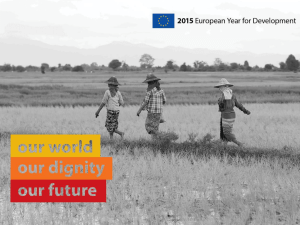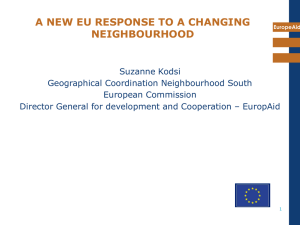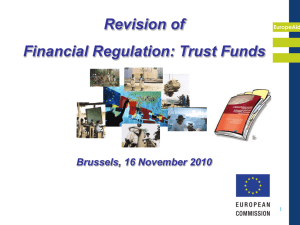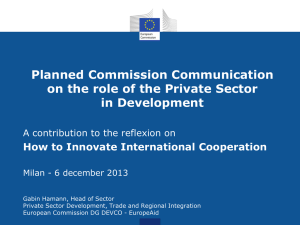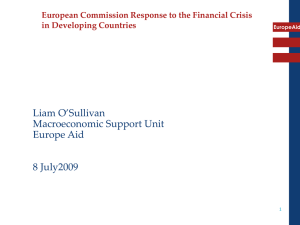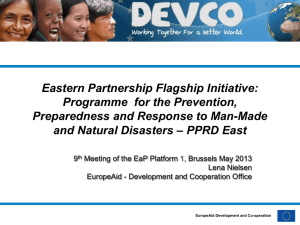EUROPEAID ACTION PLAN TO INCREASE EFFECTIVENESS OF
advertisement
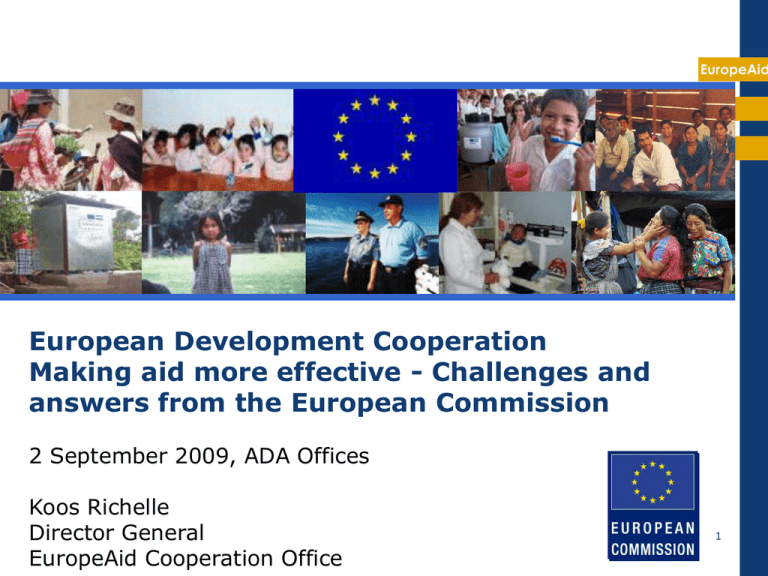
EuropeAid European Development Cooperation Making aid more effective - Challenges and answers from the European Commission 2 September 2009, ADA Offices Koos Richelle Director General EuropeAid Cooperation Office 1 Policy, Quality, Finances 2008 – 2009 EuropeAid 1. Funding and global context 2. Facts & Figures in 2008/More 3. Innovation 4. Quality/Better 5. Aid Effectiveness 6. Faster 7. Outlook 2009 and beyond 2 EuropeAid Funding and global context 3 EU and EC aid implementation EuropeAid EU the largest donor in the world • 27 + 1 donors together responsible for 60% of all development aid (2008: 48,6 billion) • USA provides 22% European Commission on its own: • Second largest donor of humanitarian aid • Third largest donor of development aid (11%, after USA and Germany) • Present in aprox. 150 countries and regions Based on OECD/DAC preliminary figures 2009 4 The EC and the external aid budget 2008 External aid: €12.8 bn (9%) Non-EuropeAid Budget: €3.3 bn (26%) Commission budget inside EU: €124 bn (91%) EuropeAid EuropeAid EDF fund: €4.8 bn (37%) EuropeAid Budget: €4.6 bn (37%) EuropeAid implements external assistance. This excludes pre-accession aid, humanitarian aid, and Common Foreign and Security Policy (CFSP) aid. EC total budget includes European Development Fund (EDF). NB – 2008 provisional figures (April 09) 5 EC development programmes as of 2007 Average annual commitments 2007-2013 • Pre-accession, 7 countries 1.6 billion • Neighbourhood, 17 countries 1.6 billion • 10th EDF, 78 ACP countries / OCTs 3.7 billion • Development, 48 countries 1.4 billion • Development, sugar, 18 ACP 180 million • Development, thematic 800 million • Human rights & Democracy 160 million • Stability (post crisis) 290 million • Nuclear safety 75 million • Humanitarian aid 802 million EuropeAid 6 EuropeAid Facts and Figures in 2008 MORE 7 Financial commitments in 2008 EuropeAid Budget & EDF commitments 2008 Planned: €7.3 bn - we did €9.3 bn Budget 5 4 EDF 3 2 1 '02 '03 '04 '05 '06 '07 0 '08 8 Paid out in 2008: €7 billion Record year for project implementation EuropeAid 8 7 6 Budget 5 4 3 EDF 2 1 0 '02 '03 '04 '05 '06 '07' '08 '09 9 Geographic distribution of funds - 2008 EuropeAid In M€ Neighbourhood south: 1137M 19% Neighbourhood east: 318M 5% Africa, Caribbean, Pacific: 3443M 60% Asia: 673M 11% Latin America: 310M 5% EuropeAid spending per region, ODA and OA, ACP including South Africa and Bananas 10 Distribution of funds by horizontal programme - 2008 EuropeAid 2008, payments per thematic programme, in M€ Stability instrument: 34M 4% Nuclear safety: 75M 8% Democracy & human rights: 112M 12% Thematic programmes*: 690M 76% 11 * Thematic programmes include: non-state actors & local authorities, investing in people, gender, environment, migration and food security EuropeAid Innovation 12 Innovation (a) EuropeAid • The Global Energy Efficiency and Renewable Energy Fund: mobilise private investments to fight climate change & poverty. EC investment = €80 million 2007-10 • Neighbourhood Investment Facility: EC grants with European Finance Institutions to generate large projects on energy, social, transport & environment. EC invest. = €50-70 million per year • EU-African Infrastructure Trust Fund: interconnecting Africa through large regional programmes. EC investment = €108.7 million 13 Innovation (b) • 7 MDG Contracts in 2008 (1,521 M€): Burkina EuropeAid Faso, Ghana, Mali, Mozambique, Rwanda, Uganda, Zambia Aid more predictable, targeted at good performers o Longer term time horizon: 6 years vs. 3 years for traditional budget support o Larger predictable share: >70% against 50%-70% o Annual performance tranche up to 15% & contract review after 3 years to determine tranche on basis of MDG-related result indicators (at least 15%) o • Mali Migration Centre • First co-financings/delegated cooperation with EU Member states 14 Innovation (c) EuropeAid Union for the Mediterranean – 2008 Builds on the Barcelona process Aim: increase regional integration & cohesion 27 EU MS + 16 Mediterranean partner states EuropeAid to implement 5 projects > €22M: Mediterranean Environment Programme EUROMED Civil Protection Programme Natural Disasters Programme* Motorways of the Seas Mediterranean Solar Plan * PPRD: Programme for the Prevention, Preparedness and Response to Man-Made and Natural Disasters 15 Innovation (d) Eastern Partnership EuropeAid Strengthen EU links with Eastern Europe & Caucasus: Armenia, Azerbaijan, Belarus, Georgia, Moldova, Ukraine Aim: deepen economic, energy, security links Eastern dimension of the EU Neighbourhood Policy Prague Summit of 7th May 2009 Five flagship initiatives: border management electricity and energy SMEs southern corridor disaster response First platform meetings foreseen June ’09 No EC budget approved yet – likely for 2010 16 EuropeAid Quality/BETTER 17 Quality EuropeAid AIDCO has a system in place to ensure and improve the quality of our operations covering the whole project cycle from the design phase, through the… implementation phase, to … ex-post evaluation of impact and sustainability 18 Quality Ex-ante phase EuropeAid Quality Support Groups (QSG) • Relatively young but already matured system of internal peer review of projects • Systematic coverage; 99% of projects screened in 2008 • QSG methodology is being aligned with Results Oriented Monitoring (ROM) to increase accountability 19 Quality Implementation EuropeAid ROM performance feedback 2008 No. of countries visited No. of monitoring reports Billion euro covered 149 1249 5.5 Stable performance on-going projects: Very good performance Good performance Performing with problems Major problems 2007 2008 4% 67% 21% 8% 3% 71% 20% 6% Improvement in African countries 20 Quality Implementation / Ex-post phase EuropeAid Ex-post ROM • Methodology of ex-post ROM (monitoring conducted one year after the completion of a project) tested and already proved to be useful in identifying factors determining projects' performance • Lessons learned are being integrated at the design phase. They are of a universal nature and can be shared with other donors or partner governments 21 Quality Implementation EuropeAid Joint monitoring Two types: o o joint monitoring carried out with other donors - ongoing dialogue within the family of international donors (in the context of Aid Practitioners Network) joint monitoring implemented together with a partner government - AIDCO is developing a new methodology based on our positive experience in Ethiopia 22 Quality Implementation EuropeAid Challenges: • Sector Policy Support Programmes - the SPSP methodology is being tested (so far 22 SPSP ROM missions in all regions); to be fine-tuned • General Budget Support – methodology for evaluation of this important aid modality is at the drawing board; GBS ROM may come later • Regional programmes - new methodology for monitoring regional programmes has been developed, being implemented 23 Quality Implementation / Ex-post phase EuropeAid 9 Evaluations concluded in 2008 • 1 Thematic: Energy • 4 Geographic: Guyana, Western Africa, Eastern Africa, Synthesis of geographical reports (’98’06) • 4 Aid modalities: Channeling aid through UN, WB, EIB, Civil Society, and an Issue paper on evaluating Budget Support • Results available on internet websites 24 EuropeAid Aid Effectiveness 25 International and EU context Policies, instruments EuropeAid • 2000 UN 8 Millennium Development Goals, fixing poverty reduction objectives for 2015 • 2005 OECD Paris Declaration, 60 recipients and 50 donors on aid effectiveness • 2005 European Consensus, the EU development policy, tying Member States and Commission • 2007 EU Code on Division of Labour • 2008 Accra High Level Forum on aid effectiveness • 2008 Doha Conference on financing for development. • 2011 Seoul High level Forum Terminus for aid effectiveness or just another stop…..? 26 EuropeAid Aid fragmentation in Nicaragua (2007) 11 dornors together 3,90% UK 1,20% Luxembourg 1,50% Japan 7,30% Austria 1,50% Sw itzerland 2,20% Japan EC 7,10% Finland 2,20% EC Sw eden Norw ay 2,40% Denmark Spain United States Germany 3,90% Sw eden 6,80% Netherlands Canada Canada 4% Germany Norw ay Denmark 6,60% Finland Sw itzerland Netherlands 5,80% Austria United States 5,90% Spain 5,90% Luxembourg UK 11 dornors together 27 Aid Fragmentation in Nicaragua (2007) EuropeAid 11 dornors together 3,90% Sw itzerland. 2,20% Norw ay. 2,40% Canada. 4% United States. 5,90% Japan. 7,30% EU+EC. 44,30% EU+EC Japan United States Canada Norw ay Sw itzerland 11 dornors together 28 Paris commitments not on track (PD Survey 2007, Global) EuropeAid On track /Achievable / Off track 2005 2010 Targets 1 Operational Development Strategies 2 Reliable Public Financial Management Systems 3 Aid flows are recorded in countries' budgets 42% 4 Technical assistance is aligned & coordinated 48% 5a Donors use country PFM Systems 40% 5b Donors use country procurement systems 39% 6 Donors avoid parallel PIUs 1832 1601 611 7 Aid is more predictable 41% 46% 71% 8 Aid is untied 75% 9 Donors use coordinated mechanisms for aid delivery 43% 10a Donors coordinate their missions 18% 20% 40% 10b Donors coordinate their country studies 42% 42% (but no progress) 66% 11 Sound frameworks to monitor results 7% 9% 38% 12 Mechanisms for mutal accountability 22% 24% 17% 75% 36% 48% 50% 85% 50% 50% 45% [80%] 43% 50-60% [80%] 88% 46% 24% 60% [100%] 66% 100% 29 EC performance not on track* (*EC has institutionalised information system to track performance against 4 EU Targets) Baseline Progress Target 2005 2007 2010 - Public Finance Management 40% 40% 60% - Procurement 41% 37% 61% - Commitments reported on budget 56% 61% 85% - Disbursements as scheduled 49% 62% 75% - Coordinated Technical Cooperation 28% 50% 100% - Parallel Project Implementation Units 204 105 68 - New parallel PIUs (EAMR Jan. 2008) 26 38 0 - Program Based Approaches 50% 46% 66% - Coordinated missions 33% 36% 66% - Shared analysis 44% 88% 66% EuropeAid Use of country systems Predictability (in-year) Capacity building Harmonisation 30 The Road Ahead: EuropeAid Action Plan EuropeAid Action plan - Priorities based on Paris & Accra Core business for All - Not only a task for experts 1. Use of country systems: TC/PIU backbone strategy; budget support and decentralised management 2. Division of labour: fast tracking initiative, delegated cooperation if needed 3. Untying of aid: assessment; revision of reporting 4. Predictability and transparency: assessment; International Aid Transparency Initiative 5. Conditionality: assessment 31 Backbone strategy for technical cooperation (TC) and project implementation units (PIU) EuropeAid 32 Use of Country Systems (d) EuropeAid Backbone strategy for TC & PIU Eight Guiding Principles 8. Consider innovative options for TC provision 7. Avoid PIU; promote effective implementat° arrangements 6. Work through harmonized and aligned actions 1. Primary aim is Capacity Development EC Technical Cooperation 5. Take account of country / sector requirements 2. Demand led approach where TC is not provided by default 3. Strong result orientation 4. Country owned & managed TC processes 33 Division of Labour monitoring (1) EuropeAid • 21 countries monitored • Donor mapping and self-assessment of comparative advantage well under way BUT: sometimes only provide general or superficial data • Lead donor arrangements in place BUT: seem to vary across countries and sectors 34 Division of Labour monitoring (2) EuropeAid • Lack of ownership by partner country (political environment, fear of aid reduction and donors’ ganging up) • Reluctance by all donors to concentrate on fewer sectors • Reluctance by non-EU-donors (UN, WB, Japan, US) • Delegated cooperation in its infancy • HQs sending contradictory signals 35 Delegated Cooperation in Practice: Status EuropeAid • 50 proposals at different stages • 36 Delegation Agreements (DA): € 214 m • 14 Transfer Agreement (TA): € 114 m • ACP DA 24/ TA 9; other EDF 3/0; Asia 5/3, LA 1/0; ENPI South 0/1; ENPI East 1/0; Thematic 2/1 • Proposals range from 0.7m up to 38.5m NB: Status in mid-July 2009 36 EuropeAid Faster 37 EuropeAid comparative study of aid implementation processes EuropeAid Objectives & Methodology • To compare aid implementation processes: average time frames; decision-making at HQ and in field offices; procedures • Challenge to compare 5 different donors (EC, AfD, SIDA, DFID, NL/DGIS) • Matrix to compare processes • Interviews (HQs & 3 partner countries) • Consultation & validation by MS 38 Main findings comparative study: Timelines Total EuropeAid From start of Programming to start of Operations - weeks DGIS 68 SIDA 100 EC 120 DFID 120 AFD Approval* = 20 wks 122 0 20 *Approval = translations, Comitology & EP scrutiny at both programming & design stages 40 60 80 100 120 140 39 EuropeAid Outlook 2009 and beyond 40 Outlook 2009: developments & challenges EuropeAid • Aid effectiveness: driving the agenda and action plan forward; EU-US cooperation • Quality: more focus on results-orientation, data quality • Institutional change: new Commission, new EP, Lisbon Treaty and External Action Service? • Responding to the international context: financial, economic, climate and food crises (and migration). Challenges, but also opportunities? Commission Spring & Fall Packages 41 Challenges for the longer term EuropeAid • MDGs: post 2015? • Results: how we can systematically present and communicate results? Is the ‘Resultaten Rapportage’ the anwer? • Development assistance beyond shared EU competence: is there still a need for bilateral aid from EU Member States? • ‘Finalité de l’aide’: how long will we continue to deliver aid and finance large shares of budgets of partner countries? Should we already stop aid to Middle Income Countries? 42 EuropeAid THANK YOU! 43
